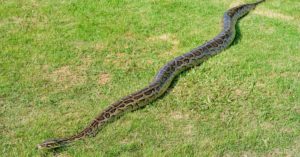Wondering if there are alligators in NC’s Lake Norman? It’s a sensible question. Lake Norman in North Carolina is a huge reservoir that’s popular with water sports enthusiasts and day-trippers. It’s well-maintained and has a pollution alert scheme, but what about dangerous wildlife? Discover if Lake Norman is home to alligators and other potentially dangerous creatures.
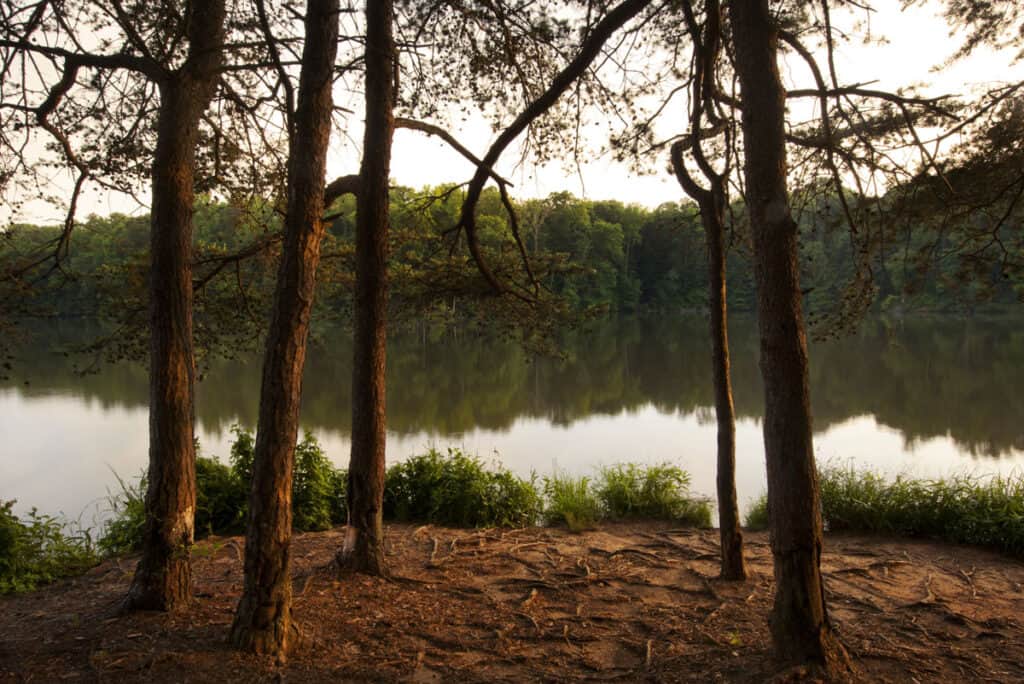
Lake Norman is popular with swimmers, kayakers, water skiers, and scuba divers.
©iStock.com/jdwfoto
Are There Alligators in North Carolina’s Lake Norman?
Although Lake Norman isn’t known for an alligator population, in 2000, several visual reports indicated alligators lurking in its depths. One video showed a five-to-six-foot-long alligator swimming in Lake Norman.
At the time, wildlife officials removed the alligators, and today, wildlife officials keep a close eye on Lake Norman because it’s a popular, biodiverse area. The chance of encountering a gator in Lake Norman is small, and alligator reports often turn out to be partially submerged logs.
The risk is small but not impossible.
Huntersville, Davidson, and Cornelius towns surround Lake Norman and occasionally report alligator sightings. Experts think alligators are slowly moving northwards as we build over their habitats and move closer to their once-wild territories.
The chance of encountering an alligator at Lake Norman is small, and it’s even lower in winter when the temperature drops below 55. Alligators are ectothermic. They need warmth to digest food and move about.

Lake Norman alligator sightings are often floating logs.
©Danita Delimont/Shutterstock.com
Is It Safe to Swim in Lake Norman?
Lake Norman is deep, up to 100 feet in some places, and alligators don’t usually head into deep water. Instead, they stick to banks and coastlines. Lake Norman is enormous. There are over 500 coastline miles, giving plenty of room for an alligator to hide. The safest places to swim in Lake Norman are the noisy, bustling areas.
Normie: Lake Norman’s Giant Aquatic Monster
Like many large lakes, Lake Norman has a legendary monster. Or is it a legend?
Normie, the lake monster, is described in several ways. His attributes include scaly fins, a dog-like head, and red eyes. Some Normie fans speculate he might be a Godzilla-like creation of the nearby nuclear power plant!
Joking aside, swimmers, boaters, anglers, and water skiers report seeing a large creature in the water that has, occasionally, chased boats and bumped scuba divers. One water skier reported Normie left a slimy substance on him that caused a rash.
Is Normie an epic alligator, monstrous catfish, massive hellbender salamander, or a gigantic bowfin fish? It’s a mystery.
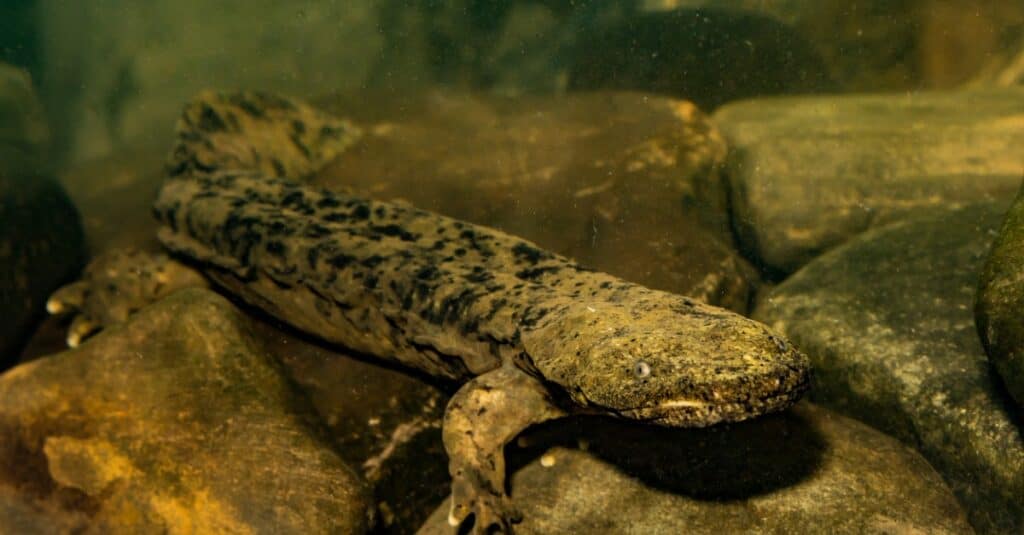
Lake Norman’s legendary creature might be a huge hellbender
salamander
.
©Jay Ondreicka/Shutterstock.com
Do Alligators Live in North Carolina?
Yes, alligators live in North Carolina’s waterways, including its creeks, lakes, marshes, swamps, ponds, and coastal areas. An estimated population of 1,000 alligators mostly live along the southeastern corner of the coast and in the Outer Banks of North Carolina. Some reports have pinned alligators as far north as the Great Dismal Swamp.
South Carolina is home to many more alligators than North Carolina. Around 100,000 alligators reside in warmer South Carolina.
Because it’s colder in North Carolina, fewer alligators live there, and those that do settle in don’t tend to reach the epic proportions of Floridian gators. The largest alligator caught in North Carolina weighed 635 pounds. This unfortunate reptile was hit and killed by a car in Manns Harbor in May 2014.
The American alligator natively lives in southern Florida, over to central Texas, and coastal North Carolina in freshwater areas. In North Carolina, the largest populations occur east of Robeson County and Gates County. Brunswick, Pender, Onslow, Craven, and New Hanover have the most.
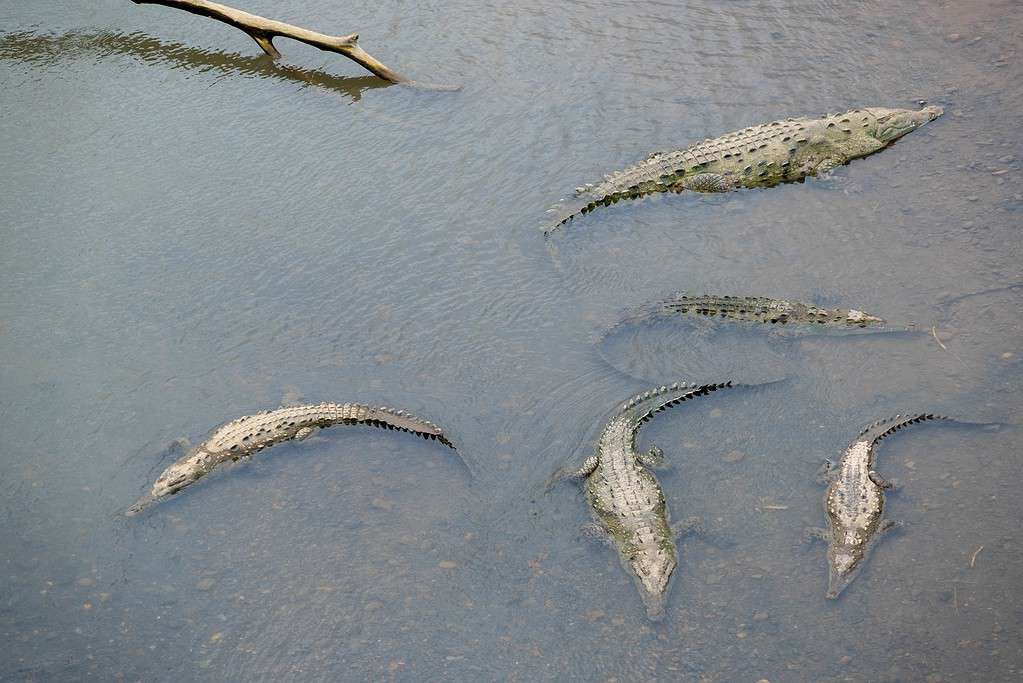
North Carolina is the northernmost point of wild alligator territory.
©Wirestock/iStock via Getty Images
All About Lake Norman, NC
Lake Norman is a huge reservoir on the Catawba River. In the 1960s, The Duke Power Company dammed the Catawba River to create hydroelectricity. Cowans Ford Hydroelectric Station and McGuire Nuclear Station perch on Lake Norman’s shores, creating small water hotspots from steam vents.
It’s North Carolina’s largest manmade lake, covering 32,750 acres, and its shoreline stretches over 520 miles, which is actually more shoreline than the entire North Carolina coastal region. Four counties border Lake Norman! Iredell, Lincoln, Catawba and Mecklenburg.
It’s a huge space, so massive that folk call it “the inland sea.” Popular with boaters, anglers, picnickers, swimming, and waterskiing, approximately 3,200,000,000 gallons of water fill it and fluctuate depending on power requirements.
Because it was constructed in the 1960s, it’s a relatively new waterway, but it’s packed with life, potentially including alligators.

McGuire Nuclear Station sits on Lake Norman’s shoreline.
©Murr Rhame, CC BY-SA 3.0 via Wikimedia Commons – License
What Else Lives in Lake Norman?
Alligators? Maybe. What else is using the lake?
Over 50 species of fish call Lake Norman home. A lucky angler caught the new state-record blue catfish there in June 2023. That whopper weighed in at 85 pounds.
Fish species include crappie, bass, bluegills, walleye, and yellow perch. Alongside species of fish, turtles, water snakes, crayfish, and heel splitter, mussels thrive.
On the shoreline, be ready to spot beaver, wild turkey, muskrat, raccoon, coyote, Virginia opossum, white-tailed deer, and eastern cottontails.
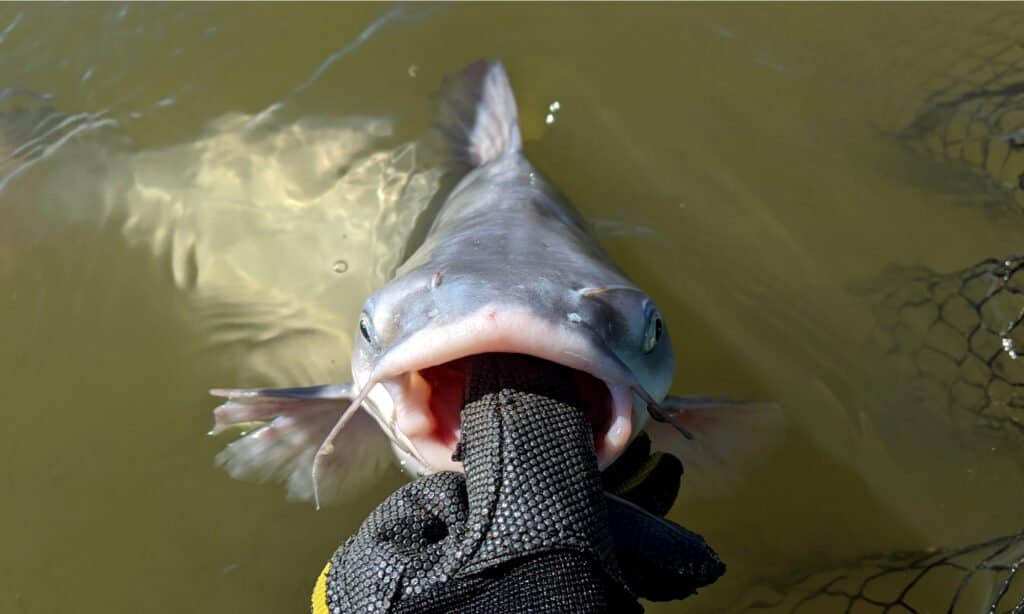
Huge blue catfish live in Lake Norman.
©M Huston/Shutterstock.com
And snakes?
Thirty-seven snake species live in North Carolina, including six venomous species. The most commonly spotted Lake Norman snake is the relatively harmless northern water snake. However, the only venomous water snake in North Carolina, the cottonmouth, could make an appearance there.
On the banks and outskirts, venomous statewide copperheads hunt rodents. Their bite is painful and needs medical attention, but it’s not often fatal. These 24-37-inch-long copper-colored snakes have distinctive hourglass bands running the length of their entire body.
As well as a potential alligator and snake population, an unusual freshwater jellyfish was discovered in Lake Norman during the late 1990s. Scientists didn’t know it was there or how it got there. Just goes to show humans don’t know everything about ecosystems.
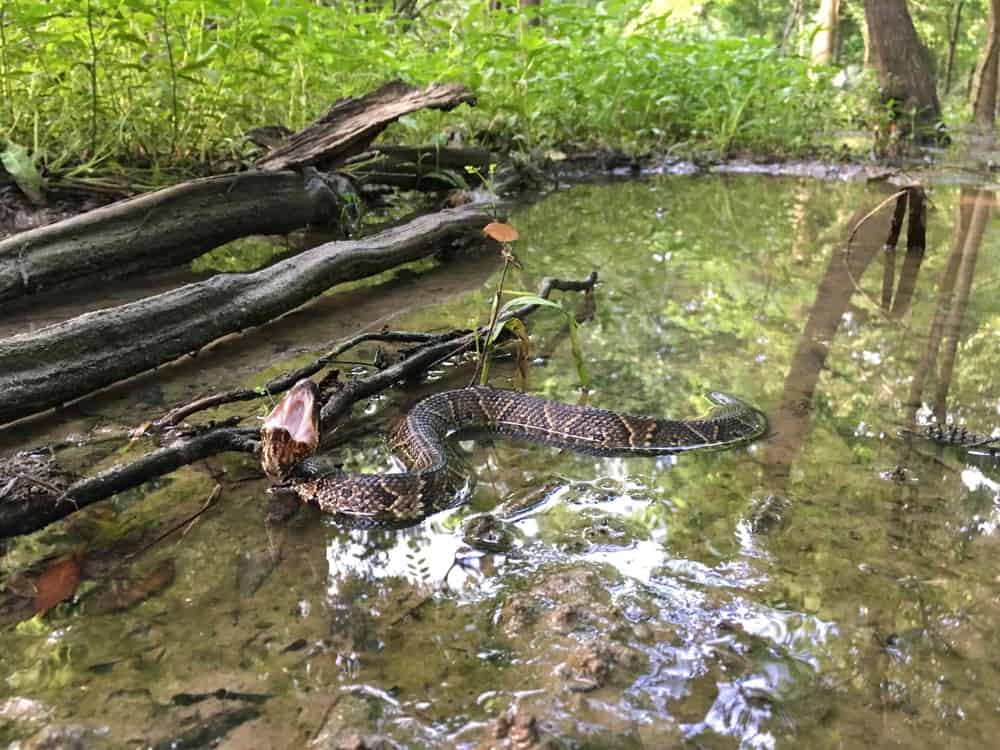
Cottonmouths live in North Carolina’s waterways.
©Joe Farah/Shutterstock.com
Alligators in the Catawba River
Lake Norman dams the Catawba River. Could alligators make it into the lake from the Catawba?
It’s unlikely because alligators are rare in the Catawba River. They inhabit South Carolina’s Catawba River near the coast, but North Carolina is colder, and alligators don’t cope well with cold. So, it’s possible alligators might live in the North Carolina’s Catawba River, but it’s not likely.
North Carolina’s Alligators
Two species of alligator exist. American alligators and Chinese alligators. Chinese alligators aren’t native to the United States, so any living in North Carolina is the American species.
Male alligators can reach 500 plus pounds and grow on average 10-12 feet long, but they can reach up to 14 feet long. Females are usually smaller, but they become more aggressive when they have a nest to protect.
American alligators are opportunistic predators. They take mammals, fish, birds, turtles, or anything that gets close, including dogs and humans. Alligators rarely kill humans. These fearsome reptiles would rather stay away from danger. The main issue is when people (illegally) feed them. This lowers their fear of humans. Food-conditioned alligators usually have to move away from human habitations, either relocated or shot by wildlife officials.
Alligators brumate over winter by hiding out in a waterside burrow. Brumating is not the same as hibernation, but brumating alligators do stop eating, and their metabolism slows.

Feeding alligators is illegal and dangerous because it encourages them to approach humans.
©Tande/Shutterstock.com
If Not Lake Norman, Then Where?
American alligators may live in Lake Norman but are not widespread there. In North Carolina, wild alligators’ range isn’t entirely known, which is why the NC Wildlife Resources Commission wants residents to report sightings.
In the United States, alligators live in Alabama, Arkansas, Florida, Georgia, Louisiana, Mississippi, Oklahoma, South Carolina, and Texas. The vast majority reside in Florida and Louisiana.
However, experts agree that alligators are being pushed further north out of their traditional territory by human expansion and resulting loss of natural territories. This means any body of water in North Carolina has the potential to home alligators.
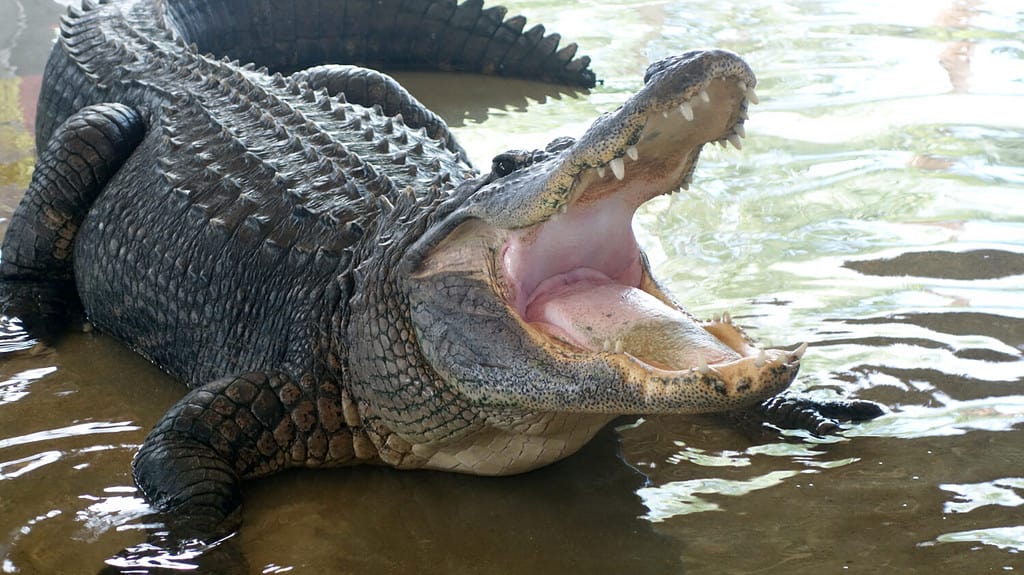
Alligators live in the southeastern part of the United States, where it is warm.
©Ernie Hounshell/Shutterstock.com
Do Alligators Live in Lake Norman, NC?
It is possible that alligators live in Lake Norman, but a report is rare.
North Carolina is the northernmost limit of wild alligators’ range, but humans’ ever-increasing expansion destroys their natural territory, so they have to find new places to live. Alligators at Lake Norman were unheard of in the past, but that could all change today and into the future.
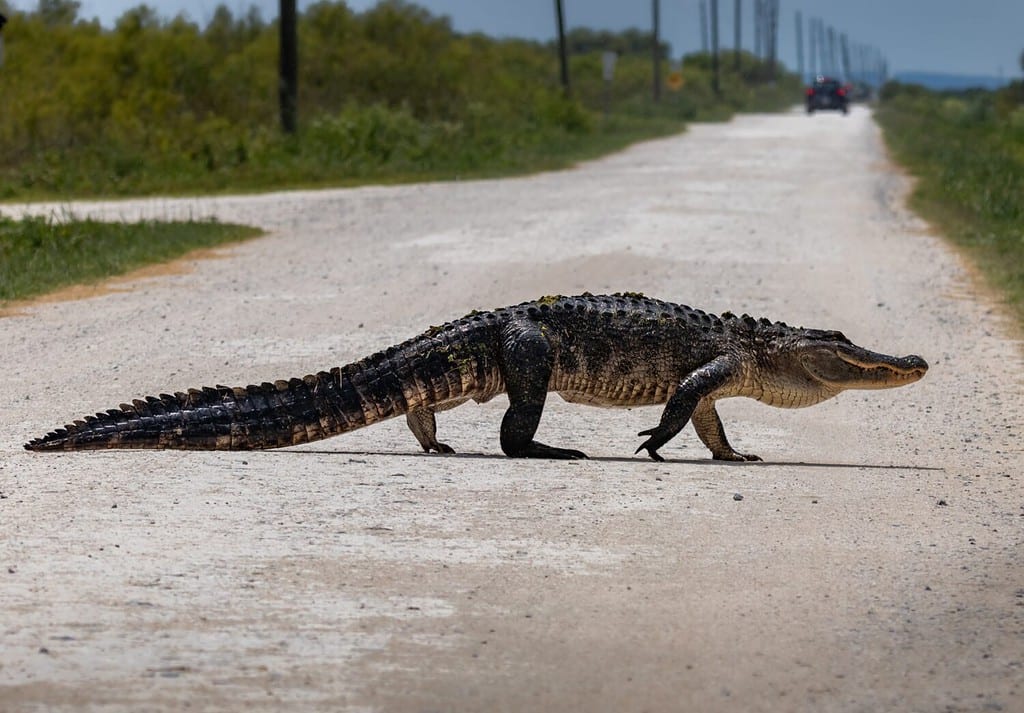
As humans push alligators from their territory, they slowly expand northwards.
©Benjamin Klinger/Shutterstock.com
The photo featured at the top of this post is © 6381380/iStock via Getty Images
Thank you for reading! Have some feedback for us? Contact the AZ Animals editorial team.



